OK, I think this topic is a very special one, and probably not of interest of many folks out there. Or how many want to create a Processor Expert Plugin for an RTOS? Well, I did this. And I think that topic might be very controversial too, especially for all the RTOS vendors out there :-). The thoughts expressed here about creating Processor Expert components do not only apply for an RTOS, but as well for any other ‘complex’ software or stack. So if you are interested about the ‘behind the scenes’ of creating Processor Expert components, especially in the context of an RTOS, then read on ;-).
The design approach of creating a Processor Expert component had several root reasons:
- I need to integrate an operating system into my project. And this was always a very time consuming task: get the RTOS sources, add them to the project, set up compiler include and search paths, build the thing with hopefully no errors.
- Usually RTOS are heavily depending on the underlying hardware: stack frames, interrupt frames, tick timer, interrupts for context switching. Yes, all RTOS providers have example projects. But rarely I have *exactly* that board or microcontroller. Which then in the end I need to make a port of the thing to my hardware.
- And finally I’m teaching embedded systems programming, and this includes using an RTOS. But here I want to focus on the concepts, and not on dealing with the issues of changing compiler settings or other ‘non-productive’ things.
In my teaching role, the last point was important. I have observed that adding/using an RTOS the ‘traditional’ way required around 3-4 hours to the students up to speed. Using the Processor Expert way allowed me to cut that time needed to less than 30 minutes.
The Beginning…
When I say RTOS, then I mean here a micro-Kernel like tinyOS, treadX, MicroC/OS-II or FreeRTOS. I have used MicroC/OS-II for education for a long time, and this RTOS still plays a role model for me: concise, fast, reliable, excellent documentation both in the source code itself and as well in the book µC/OS The Real-Time Kernel by Jean J. Labrosse (ISBN 0-87930-444-8).
The MicroC/OS-II Component
So it was a natural thing back in 2008 to have the MicroC/OS-II transformed into a Processor Expert component. The component supported the Freescale HCS12, HCS08 and ColdFire architectures.
In the next picture you see the uCOS Processor Expert view as shown in CodeWarrior (both Classic and Eclipse):
There were several innovative parts with this approach:
- The RTOS source files are generatedand stored in the project structure. Usually you have the RTOS somewhere in a folder, and then you refer to it like a library. This approach (the ‘library’ one) has the advantage of having just a single instance of the RTOS. But as soon as you need it for several architectures/products or start changing it, you are in troubles. And because the RTOS is ‘external’ to the project, it requires some setup. As the RTOS file size is not big, and as generating the files on demand is such an easy thing with Processor Expert, the benefit having the source files in the project locally was a plus for me.
- The earlier point has another positive result: with the Processor Component approach, the component can contain all the sources (generated). As such, it is really easy to pass the RTOS to the students or install it on another machine: I simply pass the Processor Expert component as a ‘package’, and everything is in a single file.
- Easier to use: simply add the component, configure it, generate code, compile and run. The component exposes the RTOS API calls like OSInit(), OSStart(), OSQPost() etc. With Processor Expert every method usually has a prefix (you can specify) in front of every function name. The implementation is using simple macros (e.g.
#define uCOS1_OSStart() OSStart()): - Online Help: You can hover with the mouse over it, and it will show you the API description. No need to consult the manual.
- Configuration: The RTOS configuration file is generated. Instead of manually configure the os_config.h for MicroC/OS-II, I have a graphical editor with tool tip help to make things easy to use:
That component and approach worked out very well.
Licensing
It worked very, very well in a teaching and university environment. Because source code is provided for free for educational use or for peaceful research. For commercial usage a license is required, in my view very affordable.
At the Lucerne University of Applied Sciences and Arts we have up to 40-60% students which study 2-3 days a week, and work in their normal job the rest of the time. Their wish was to learn and apply something in the lab, they easily could transfer into their own commercial product work in their companies. And here the licensing thing was a hindering point. The question I was asked was: “why can we not use something open source?”.
That would have solved as well another problem: as the uC-OS component includes the RTOS sources, I would need distribution rights from Micrium (the company owning MicroC/OS-II).
FreeRTOS
Looking out for an open source alternative, one thing stood out of the 2011 Embedded Market Study: FreeRTOS. Although it has some conceptual differences (heap, stack allocation, process priorities) compared to MicroC/OS-II, it was a very valuable alternative. And it has a very friendly Open Source license, solving the above two issue points (distribution rights and need for licensing).
FreeRTOS Processor Expert Component
But what was missing was a Processor Expert Component for it. With the experience gathered with the creation of the MicroC/OS-II component it was not that hard. An it is officially available on the web since September 2011 on the Embedded Component download page.
Similar to the MicroC/OS-II component it offers methods and events to the RTOS API:
The component offers properties to configure the RTOS. The settings are generated into the RTOS configuration file FreeRTOSConfig.h:
This component is constantly evolving and has been extended as well with Tracing capabilities (see Tracing FreeRTOS with a Hardware Probe and Tracing with FreeRTOS+Trace from Percepio) and supports following architectures:
- Freescale S08 family of processors
- Freescale S12, S12X family of processors
- Freescale ColdFire V1 and ColdFire V2
- Freescale Kinetis ARM Cortex M4 and M4F family
There is work in progress (not fully supported yet) for the Freescale DSC family of processors. Beside of the various Freescale compilers, gcc support is being added now and will be available with the next version.
Ok, that’s for the introductory part. The next posts will be around how to code and hack an RTOS Processor Expert Component. Will be fun :-).
Happy Componentizing 🙂

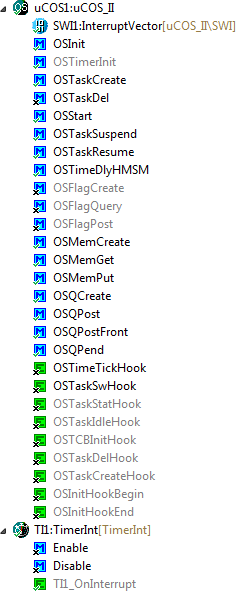
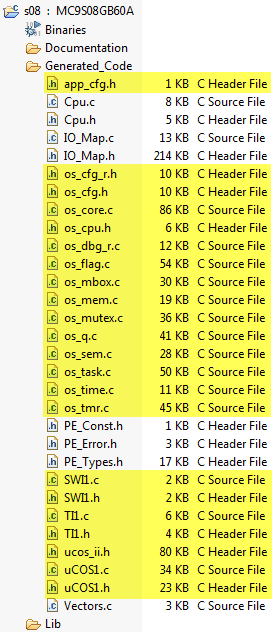

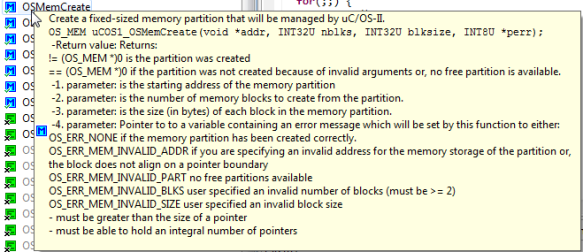
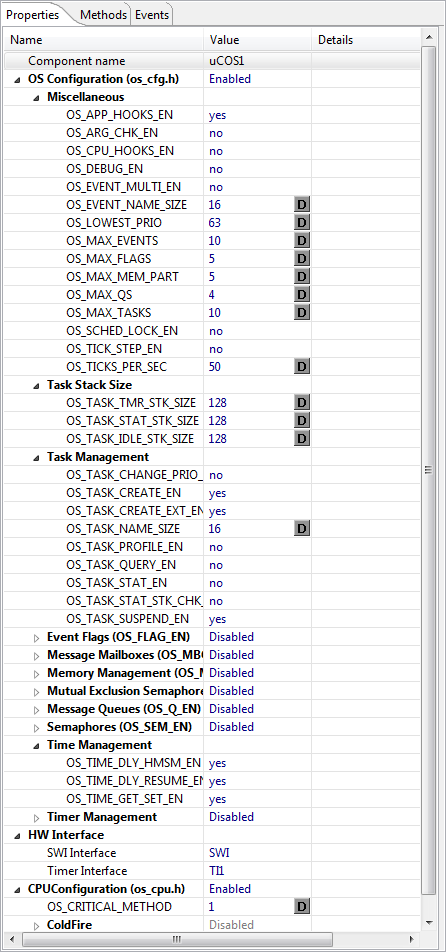

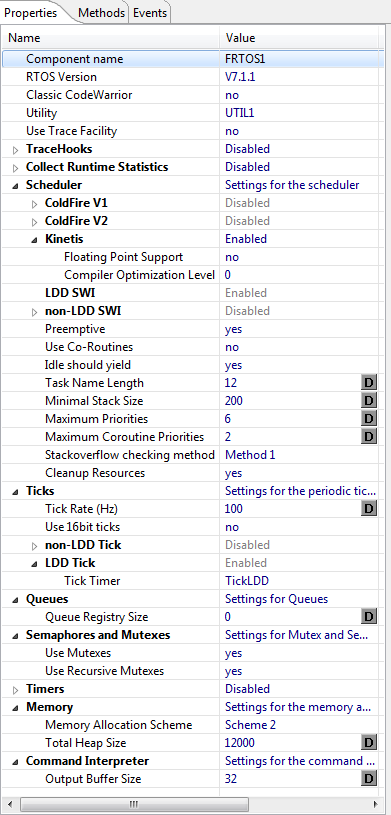
Pingback: CDE Hacking: Where is my stuff? A dissection… | MCU on Eclipse
Pingback: CDE RTOS Hacking: Show it as an RTOS component | MCU on Eclipse
Pingback: CDE Hacking: Components with Multiple Files | MCU on Eclipse
Pingback: There is a Time and Date for both Worlds | MCU on Eclipse
Hi Erich,
I have tried to add the component uCOS_II to a project with this result:
Generator: FAILURE: at line 1: Error in including “Drivers\sw\uCOS_II.drv” (file: Drivers\uCOS_II.src)
and clicking on the error message:
%include sw\uCOS_II.%DriverExtension
I’m using CW 10.5. What I’m doing wrong?
Regards,
Juan
LikeLike
Hi Juan,
which microcontroller are you using? I used it with the HCS08. The other thing is: I’m not allowed to distribute the uCOS RTOS sources, so the component alone is not enough, you need to license the uCOS operating system.
LikeLike
Hello Erich,
my mcu is MCF51CN128, now I’m using FreeRTOS and the result cannot be better! But, as this project in now in production/maintenance mode I will try to find a RTOS as alternative for fun & research. So that in this way I have arrived to this page about uCOS II. But I will discard and search other alternatives. Thanks anyway and congratulations for your excellent site!
Regards,
Juan
LikeLike
Hi Juan,
thanks :-).
I moved all my projects to FreeRTOS now (I still have a few in maintenance mode with uCOS-II). For me, there is no reason to stick with uCOS-II as FreeRTOS has pretty much replaced it everywhere in the industry. With the exception of some safety critical applications where uCOS-II has benefits (but uCOS-II is not free or open source). The biggest advantage of uCOS-II is static stack allocation: however, this is now possible with FreeRTOS too. If you find other/good alternatives, let me know.
LikeLike
Outstanding, thanks Erich. I did not know that FreeRTOS supported the S08, and it’s thanks to your efforts it seems. I’m looking for an RTOS that can operate across a few different architectures, including the DSC’s, and now I see FreeRTOS has a low power tickless mode. Well, it looks like I might have found it. Thanks again.
LikeLike
Hi James,
yes, in fact I used FreeRTOS first for S08 (in parallel with the S12), and only later I expanded the FreeRTOS port with ColdFire and ARM. DSC is the latest addition, but I admit I have used DSC only on an experimental level.
LikeLike
Hi, I have just started working with uCOS-III and am working with some HCS08 and HCS12 series microcontrollers. Considering that I saw in this post that in 2013 you said “I’m not allowed to distribute the uCOS RTOS sources” and “you need to license the uCOS operating system”. But now Micrium has made this operating system open source, can I get the Processor Expert Component related to uCOS from you now?
With respect
LikeLike
I have completely moved away from uCOS for probably 8 years or so and ownership of uCOS changed over time. I have not touched that uCOS component for many years. As it contains the sources from that time with that license agreement, I’m not allowed to distribute it, as I’m still bound to the license from that time. And I don’t plan to migrate it to the newer OS or to use uCOS.
LikeLike